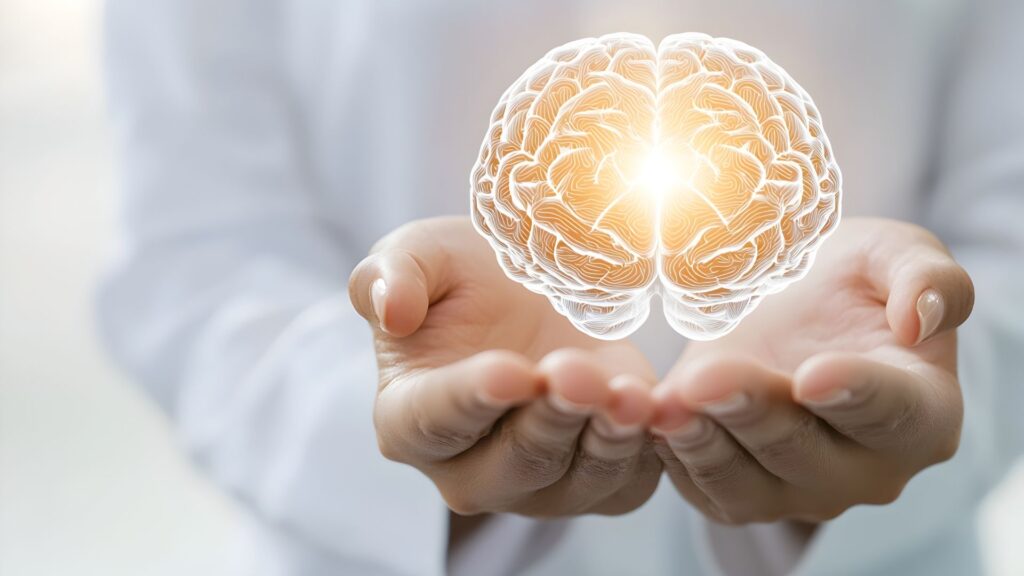Transcranial magnetic stimulation (TMS) is gaining attention as a promising treatment for bipolar disorder, especially bipolar depression, when other therapies fall short. This noninvasive method uses magnetic pulses to target brain areas linked to mood regulation.
In this article, we break down how TMS is used for bipolar disorder, examine its safety and effectiveness, and explain what patients can expect. We also touch on who may benefit and highlight ongoing research shaping its future in bipolar care.

What Is TMS and How Does It Work?
Transcranial magnetic stimulation is a therapy that uses magnetic pulses delivered through an insulated coil placed on the scalp to stimulate nerve cells in targeted areas of the brain. In bipolar disorder, the prefrontal cortex, especially the left dorsolateral prefrontal cortex, is commonly targeted because this region plays a key role in mood regulation and is often underactive during depressive episodes.
The use of repetitive transcranial magnetic stimulation (rTMS) involves delivering multiple magnetic pulses over several sessions, typically lasting about 30 to 60 minutes each. Unlike deep TMS, which stimulates a broader and deeper area of the brain, conventional TMS focuses on more superficial cortical regions associated with mood control. This magnetic stimulation in the treatment of bipolar disorder aims to modulate brain activity, improving depressive symptoms without surgery or medication side effects.
Many specialized centers, particularly neuro-wellness facilities, now offer rTMS therapy services as part of a comprehensive mental health program. These centers often integrate this with other therapeutic approaches, such as nutritional support, to promote overall brain health and emotional well-being.
Why Consider TMS for Bipolar Disorder?
TMS has become an attractive treatment option for bipolar disorder because many patients with bipolar depression do not respond adequately to medication or experience intolerable side effects. The use of the therapy for treatment-resistant bipolar depression offers a noninvasive, well-tolerated alternative that could reduce depressive symptoms such as low energy, hopelessness, difficulty concentrating, and changes in sleep or appetite.
Since bipolar disorder is characterized by mood swings including episodes of depression and mania, this particular kind of therapy may be particularly helpful for patients in the depressive phase who have limited options. The Food and Drug Administration (FDA) has approved the program for major depressive disorder and obsessive-compulsive disorder, but not yet specifically for bipolar disorder. However, it is increasingly being explored off-label as an adjunct or standalone treatment for people struggling with bipolar depression.
Effectiveness of TMS in Bipolar Disorder
Research on its efficacy for bipolar disorder is still emerging but shows promising results, especially in treating bipolar depression. Several small studies and case reports have demonstrated that this treatment can significantly improve depressive symptoms in patients with bipolar disorder, sometimes with response rates comparable to those seen in unipolar depression.
For example, high-frequency TMS applied to the left prefrontal cortex may increase cortical activity and alleviate depressive symptoms. Some studies suggest that it could also help improve cognitive symptoms like brain fog and concentration difficulties common in bipolar depression. While results on its effects in treating manic episodes are less consistent, the therapy remains a promising adjunctive treatment that may complement medication and psychotherapy. Patients typically undergo daily treatment sessions over several weeks to achieve the best results.
How TMS Is Delivered for Bipolar Disorder
Treatment protocols for bipolar disorder generally involve repeated sessions performed over several weeks. Each therapy session lasts around 20 to 40 minutes, during which magnetic pulses are targeted at the prefrontal cortex using an electromagnetic coil. The frequency and intensity of pulses can vary based on individual symptoms, with high-frequency stimulation usually applied to excite underactive brain regions implicated in depression.
Advanced imaging techniques may be used to precisely locate the target area in the brain, optimizing response to treatment. Typically, patients receive treatment five days a week for four to six weeks, but some newer protocols incorporate accelerated schedules with multiple sessions per day. Adjustments are made depending on clinical progress and any side effects.

Potential Side Effects and Risks
TMS is generally well-tolerated with fewer side effects than many medications. The most common effects during or after a session include mild headache, scalp discomfort at the site of stimulation, tingling sensations, and lightheadedness. Rare but serious risks, such as seizures, are extremely uncommon but require careful screening and monitoring.
Since bipolar disorder involves vulnerability to mood swings, there is some concern that it could potentially trigger manic or hypomanic episodes in susceptible patients. Therefore, providers closely monitor for any signs of mood elevation during treatment. Safety precautions also include avoiding therapy in patients with metal implants or a seizure history unless cleared by a neurologist. Overall, the benefits of TMS often outweigh these manageable risks when used appropriately.
Who Is a Potential Candidate?
Candidates for the treatment typically include patients with bipolar disorder currently experiencing a depressive episode who have not achieved sufficient relief from medication or psychotherapy. Eligibility usually requires a thorough psychiatric and medical evaluation to rule out contraindications such as implanted metallic or electronic devices (e.g., pacemakers), recent seizures, or certain neurological conditions.
Patients with a history of epilepsy or severe manic episodes may not be ideal candidates unless carefully supervised. Since TMS therapy requires daily clinic visits for several weeks, candidates should also be able to commit to this schedule. Consulting with a multidisciplinary team is advised to determine the suitability of the therapy as part of an individualized bipolar disorder treatment plan.
What to Expect: The Patient Experience
A typical session is an outpatient procedure involving positioning a magnetic coil on the scalp and delivering repeated magnetic pulses. Patients are awake during sessions and can resume normal activities immediately afterward. The treatment is painless, though some may feel slight tapping or clicking sensations.
Multiple sessions are required to see meaningful improvements, usually five days a week over four to six weeks. Patients may notice gradual symptom relief and better mood stability as treatments progress. Insurance coverage for the therapy varies, so costs and reimbursement should be discussed beforehand. Ongoing maintenance sessions may be recommended to sustain benefits.
Limitations and Indications for Research
Although TMS shows great potential for bipolar depression, it is not yet FDA-approved specifically for bipolar disorder, highlighting the need for further large-scale controlled trials. The optimal stimulation parameters, long-term efficacy, and safety profiles in bipolar patients remain under investigation.
Research is ongoing to determine how to minimize risks such as manic switching and to fine-tune treatment protocols tailored to bipolar disorder’s unique pathophysiology. This form of therapy is not a cure but a complementary part of comprehensive disorder treatment, including medications and therapy.
Tips for Patients and Families
Patients and families considering TMS for bipolar disorder should inquire about the provider’s experience with bipolar depression treatment specifically. It is important to ask about the expected treatment schedule, potential side effects, and how it will fit with current medications. Collaboration between psychiatrists, neurologists, and specialists helps ensure careful monitoring of mood changes and adverse effects.
Ongoing medication adherence and psychological support remain crucial during transcranial magnetic stimulation therapy. Staying informed about emerging research and being proactive in communication with clinicians can improve treatment outcomes.
Final Thoughts from Quantum Wellness Center
TMS therapy could offer significant relief to patients struggling with depressive symptoms unresponsive to traditional therapies. As research advances, the treatment may become an integral component of disorder treatment, providing targeted brain stimulation to improve mood and functioning.
At Quantum Wellness Center, discover how cutting-edge, non-invasive therapies like rTMS can help you reclaim balance, boost brain health, and live life with renewed energy and purpose. We’re proud to bring the benefits of rTMS treatment closer to you, with multiple convenient locations designed for your comfort, ease of access, and a luxurious and peaceful setting that promotes healing.



